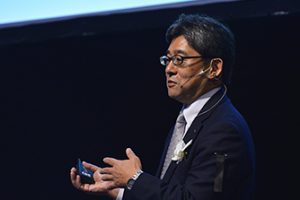How does the Fujitsu Hyperconnected Van work?
Bazin: We built it for the utilities industry, but it has broader applicability. There are lots of benefits, particularly for mobile field offices. The core feature is to improve what we call first fix. Someone comes to fix something but doesn’t have the right parts, so has to come back later.

That’s disappointing for customers and expensive for industry. Visibility of mobile stock inventory, using RFID tagging, is really valuable. The other part provides connectivity and widgets into a mobile Wi-Fi hotspot.
One of the challenges in field conditions is engineers have no signal inside buildings to look at manuals. The hotspot can give them continual connectivity back to base.
“Nobody buys IoT. What they buy is a solution to a business problem.”
Alex Bazin, VP and Head of IoT, Fujistu
What is Human-Centric Innovation about?

Suga: We aim to benefit people through ICT. Our concept has quantitative—productivity and costs—and qualitative—making life richer, providing better working environments, and motivating people—aspects. I don’t think many competitors are using this approach. When you talk about IoT, that’s a huge range of devices, from big to small, and you have to integrate them all. That’s where we can help![]()









